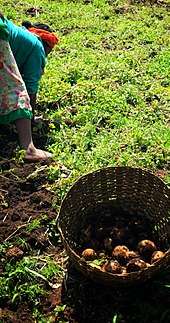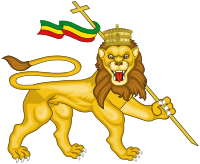Gurage people
The Gurage people (/ɡʊəˈrɑːɡeɪ/)[5] are an Habesha Ethiosemitic-speaking ethnic group inhabiting Ethiopia.[2] The Gurage people traditionally inhabit a fertile, semi-mountainous region in southwest Ethiopia, about 125 kilometers southwest of Addis Ababa, bordering the Awash River in the north, the Gibe River (a tributary of the Omo River) to the southwest, and Lake Zway in the east. In addition, according to the 2007 Ethiopian national census the Gurage can also be found in large numbers in Addis Ababa, Oromia Region, Dire Dawa, Harari Region, Somali Region, Amhara Region, Gambela Region, Benishangul-Gumuz Region, and Tigray Region.[6]
| Total population | |
|---|---|
| about 1,734,000+[1] | |
| Regions with significant populations | |
| Languages | |
| Gurage | |
| Religion | |
| Christianity, Islam, traditional faith[2][3] | |
| Related ethnic groups | |
Language
The dialects spoken by the Gurage are collectively known as Gurage Af or Guraginya in Amharic. The Gurage dialects evolved from a Proto-Gurage language or a parent Gurage language, as do all dialects do. The similarities among these dialects are used to group the Gurage dialects into three subgroups: Northern, Eastern and Western. The number of Gurage dialects there are is not yet known. Gurage Af is one of the Ethiopian semitic languages but as Amharic and Tigrinya, it did not escape the influences of the surrounding Cushitic languages.
The dialects are Soddo (including Goggot), Masqan, Inor (including Gyeto and Endegegn), Mesmes (extinct), Sebat Bet Gurage (including Chaha, Ezha, Gumer, Gura, Muher), Zway, and Siltʼe (including Wolane, Ulbare and Inneqor). Gurage dialects represent clans of Gurage that live in free federation. Gurage languages is Related with Ge'ez. Gurage is written left-to-right using a system that grew out of the Ge'ez script. Alternative scripts have not been studied for writing Gurage Af, and there is no desire to do so amongst the Gurage, aside from transliteration purposes.
Description

According to the historian Paul B. Henze, their origins are explained by traditions of a military expedition to the south during the last years of the Kingdom of Aksum, which left military colonies that eventually became isolated from both northern Ethiopia and each other.[7] However other historians have raised the issue of the complexity of Gurage Peoples if viewed as a singular group, for example Ulrich Braukhamper states that the Gurage East people may have been an extension of the ancient Harla people. Indeed, there is evidence that Harla architecture may have influenced old buildings (pre-16th c.) found near Harar (eastern Ethiopia), and the Gurage East group often cite kinship with Harari (Hararghe) peoples in the distant past. Braukhamper also states King Amda Seyon ordered Eritrean troops to be sent to mountainous regions in Gurage (named Gerege), which eventually became a permanent settlement. In addition to Amda Seyon's military settlement there, the permanence of Abyssinian presence in Gurage is documented during his descendants Zara Yaqob and Dawit II's reigns. Braukhamper also notes that some Amhara troops and their families likely fled areas in modern-day Gondar and Gojjam into the Gurage region during the Ethiopian-Adal War of the 1530s, since Abyssinia was drastically outgunned by the Adal troops which received supplies and arms from the Ottoman Empire. Thus, historically, Gurage peoples may be a complex mixture of Abyssinian, Harla, and other groups which migrated and settled in that region for differing reasons.[8]
The majority of the inhabitants of the Gurage Zone were reported as Muslim, with 51.02% of the population reporting that belief, while 41.91% practiced Ethiopian Orthodox Christianity, 5.79% were Protestants, and 1.12% Catholic.[9] According to the 1994 Ethiopian census, self-identifying Gurage comprise about 2.7% of Ethiopia's population, or about 1.4 million people.[10] The populations of Gurage people are not exactly known because approximately half of the population live outside of the Gurage zone.
The Gurage live a sedentary life based on agriculture, involving a complex system of crop rotation and transplanting. Gurage people are known as hard workers and as a model of good work culture in the whole Ethiopia.Ensete is the main staple food, but other cash crops are grown, which include coffee and khat, both traditional stimulants. Animal husbandry is practiced, but mainly for milk supply and dung. Other foods consumed include green cabbage, cheese, butter, and roasted grains, with meat consumption being very limited (also used in rituals or ceremonies).
The Gurage, the writer Nega Mezlekia notes, "have earned a reputation as skilled traders".[11] One example of an enterprising Gurage is Tekke, who Nathaniel T. Kenney described as "an Ethiopian Horatio Alger, Jr.": "He began his career selling old bottles and tin cans; the Emperor [Haile Selassie] recently rewarded his achievement in creating his plantation by calling him to Addis Ababa and decorating him."[12]
Agriculture and ensete

The principal crop of the Gurage is ensete (also enset, ensete edulis, äsät or "false banana plant"). This has a massive stem that grows underground and is involved in every aspect of Gurage life. It has a place in everyday interactions among community members as well as specific roles in rituals. For example: the ritual uses of Ensete include wrapping a corpse after death with the fronds and tying off the umbilical cord after birth with an ensete fiber; the practical uses include wrapping goods and fireproofing thatch.[13] Ensete is also exchanged as part of a variety of social interactions, and used as a recompense for services rendered.[14]
Ensete is totally involved in every aspect of the daily social and ritual life of the Gurage, who, with several others tribes in Southwest Ethiopia, form what has been termed the Ensete Culture Complex area... the life of the Gurage is enmeshed with various uses of ensete, not the least of which is nutritional.[13]
Ensete can be prepared in a variety of ways. A normal Gurage diet consists primarily of kocho, a thick bread made from ensete, and is supplemented by cabbage, cheese, butter and grains. Meat is not consumed on a regular basis, but usually eaten when an animal is sacrificed during a ritual or ceremonial event.[13] The Gurage pound the root of the Ensete to extract the edible substance, then place it in deep pits between the rows of ensete plants in the field. It ferments in the pit, which makes it more palatable. It can be stored for up to several years in this fashion, and the Gurage typically retain large surpluses of ensete as a protection against famine.[14] The resulting paste is used to make porridge and bread. The only way to eat ensete is to make into a paste.
In addition to ensete, a few cash crops are maintained (notably coffee and khat) and livestock is raised (mainly for milk and fertilizer). Some Gurage also plant teff and eat injera (which the Gurage also call injera).[15]
The Gurage raise zebu. These cattle are primarily kept for their butter, and a typical Gurage household has a large quantity of spiced butter aging in clay pots hung from the walls of their huts. Butter is believed to be medicinal, and the Gurage often take it internally or use it a lotion or poultice. A Gurage proverb states that "A sickness that has the upper hand over butter is destined for death." Different species of ensete are also eaten to alleviate illness.[16]
The Gurage regard overeating as coarse and vulgar, and regard it as poor etiquette to eat all of the ensete that a host passes around to guests. It is considered polite to leave at least some ensete bread even after a very small portion is passed around.[17]
It is typically expected that a Gurage will extend hospitality to their neighbors and kinfolk in dispensing ensete freely to them.
Food
The Gurage in rural highland areas centre their lives on the cultivation of their staple crop Ensete. Kocho is made by shaping the ensete paste to a thick circle and wrapping it in a thin layer of ensete leaves. Its baked in a small pit with coals. Sometimes the paste is just cooked over a griddle. Kitfo a minced raw beef mixed with butter and spicy pepper is commonly attributed to the Gurage.
Please list them separately as Historical and Present Notables
Historical Gurages
- Ras Desta Damtew (አባ ቀማው) - was an Ethiopian noble, an army commander, and a son-in-law of Emperor Haile Selassie I.
Notes
- "Census 2007" Archived 2012-02-14 at the Wayback Machine, first draft, Table 5.
- G. W. E. Huntingford, "William A. Shack: The Gurage: a people of the ensete culture"
- Lebel, Phillip. 1974. "Oral Traditional and Chronicles on Guragé Immigration".
- Joireman, Sandra F. (1997). Institutional Change in the Horn of Africa: The Allocation of Property Rights and Implications for Development. Universal-Publishers. p. 1. ISBN 1581120001.
- "Gurage". Merriam-Webster Dictionary.
- Table 3.1 on 2007 Ethiopian Regional States Census Data Archived 2016-08-24 at the Wayback Machine
- Henze, Layers of Time (New York: Palgrave, 2000), p. 112.
- Braukamper, Ulrich (2002). Islamic History and Culture in South Ethiopia. LITverlag. p. 18. ISBN 9783825856717. Retrieved 25 June 2016.
- Statistical Report (Report). CSA. November 2007. Archived from 2007 CSA the original Check
|url=value (help) on 2012-11-13. Retrieved 2 March 2013. - Ethiopia: A Model Nation of Minorities Archived 2011-07-18 at the Wayback Machine (accessed 6 April 2006)
- Nega Mezlekia, Notes from the Hyena's Belly (New York: Picador, 2000), p. 227.
- Kenney, "Ethiopian Adventure", National Geographic, 127 (1965), p. 582.
- Shack, Dorothy. "Nutritional Processes and Personality Development among the Gurage of Ethiopia" in Food and Culture: A Reader. Ed. Carole Counihan and Penny van Esterik. (New York: Routledge, 1997). p117.
- Shack, Dorothy. "Nutritional Processes and Personality Development among the Gurage of Ethiopia" in Food and Culture: A Reader. Ed. Carole Counihan and Penny van Esterik. (New York: Routledge, 1997). p121.
- Girma A. Demeke and Ronny Meyer (14 June 2011). "Contact-induced language change in selected Ethiopian Semitic Languages" (PDF). Centre français des études éthiopiennes. Archived from the original (PDF) on 2014-11-06. Retrieved 6 November 2014.CS1 maint: uses authors parameter (link)
- Hunger, Anxiety, and Ritual: Deprivation and Spirit Possession Among the Gurage of Ethiopia Author(s): William A. Shack Source: Man, New Series, Vol. 6, No. 1 (Mar., 1971), pp. 30-43
- Hunger, Anxiety, and Ritual: Deprivation and Spirit Possession Among the Gurage of Ethiopia Author(s): William A. ShackSource: Man, New Series, Vol. 6, No. 1 (Mar., 1971), pp. 30-43
References
- Lebel, Phillip, 1974. "Oral Traditional and Chronicles on Guragé Immigration." in Journal of Ethiopian Studies by Institute of Ethiopian Studies. Vol. 12 (2): pp. 95-106.
- G. W. E. Huntingford, 1966. Bulletin of the School of Oriental and African Studies, 29, pp 667–667 doi:10.1017/S0041977X00073857
- Shack, William, 1966: The Guraghe. A People of the Ensete Culture, London – New York – Nairobi: Oxford University Press.
- Shack, William,1997: "Hunger, Anxiety, and Ritual: Deprivation and Spirit Possession among the Gurage of Ethiopia" in Food and Culture: A Reader (pp. 125–137). Ed. Carole Counihan and Penny van Esterik. New York: Routledge.
- Worku Nida 2005: "Guraghe ethno-historical survey". In: Siegbert Uhlig (ed.): Encyclopaedia Aethiopica. Vol. 2: D-Ha. Wiesbaden: Harrassowitz. pp. 929–935.
External links
- Gurage Research blog
- Gurage and Silte Research Group
- The Gurage People – Carolyn Ford with SIM in Ethiopia
- Facts about Gurage
- GeoHive
- Google map of Gurage
